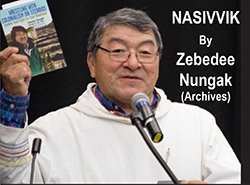
NASIVVIK By Zebedee Nungak,
Windspeaker Columnist; Archives 2005
Nasivvik is an Inuktitut word that means vantage point. It can be a height of land, a hummock of ice, or any place of elevation that affords observers a clear view of their surroundings to make good observations.
The APTN has announced a new policy that would require future film productions shot in Inuktitut to have versions dubbed in English and/or French, as well as one or more other Aboriginal language. As a result, APTN has been subjected to a chorus of strong criticism from many influential Inuit, among them Atanarjuat producer Zacharias Kunuk, Nunavut Minister of Culture, Language, Elders and Youth Louis Tapardjuk, and Inuit Tapiriit Kanatami President Jose Kusugak.
As a long-time critic of Inuit being in APTN at all, I say, "Congratulations, APTN! You have presented one more reason out of many to demonstrate why Inuit should get out of your structure altogether. Thank you for revealing your position on the Inuktitut language. Your dubbing policy may serve a very useful purpose by sparking discussions among Inuit about where they want Inuktitut programs to be embedded. This may just launch a search for alternatives to APTN."
APTN language priorities were further exposed by its CEO, Jean LaRose, who is quoted as saying, "Let's face it, there are many Aboriginal people in Canada who have lost their language and need to hear the story in English or French." To which, I say, "Let APTN be the network to bottle-feed English and French to those Aboriginal people who have lost their language, and who are not in much of a position to reclaim it."
Inuit, who are determined to preserve their language, should refuse to be any part of this. They should get busy fast-tracking into existence a new, independent network devoted exclusively to Inuit. Despite its apparent health, the Inuktitut language already has diverse pressures bearing down upon it. We don't need an additional one from APTN, from which we should have expected enhancement, and not dilution, in efforts to maintain Inuktitut as a vibrant, living language.
The conditions of APTN's license from the CRTC give a clear indication of what rules its policy for languages. Sixty per cent of its programming is to be in English, 15 per cent in French, and 25 per cent in Aboriginal languages. In this framework, Canada's official languages, which are in no danger of extinction, hog the lion's share of the language equation in a network supposedly devoted to Aboriginal people! Aboriginal languages here are pre-disposed to being crowded out.
At APTN, Inuktitut is a square peg trying to fit in a round hole. There may well be a fundamental chasm in understanding between APTN as an organization operating within a pre-set formula for language allocations on one hand, and Inuit with a vision of utilizing the medium of television to help maintain the health and viability of the Inuktitut language.
Inuit desire ownership of Inuktitut language television programming primarily to keep the language and culture alive for its sake; not necessarily to showcase this to others. Inuit communications societies have not defined their primary mission as that of exposing Inuit culture to larger society. My take of Inuit attitudes on this is, "If our fellow countrymen in Canada are curious about who we are, and why we hold our identity, that is very good. But it is for us and our children that Inuit television productions should be working hardest."
This is where APTN's latest policy statement diverges from the interests of Inuit who want television and film to be tools useful primarily to the Inuit people, and the Inuit world. Inuit want these mediums to be working for them, to help keep Inuit-ness alive. Dubbing Inuktitut productions into other languages is not useful to Inuit at all. It does nothing to enhance the preservation of Inuktitut. It is for the benefit of non-Inuit who cannot understand the Inuktitut language.
Inuktitut programming is scarce enough without having to share versions of itself in other languages, in a framework where Aboriginal languages are already far too junior in the general equation. APTN appears totally indifferent to what practical problems this policy might cause. There will be, say, four versions of the same program being aired at various times. Who will vacate their previous space in the schedule to make this possible?
Many Inuit hold a desire to see a broadcasting network devoted solely to Inuit and the Arctic. They believe that, with several dialects of Inuktitut to maintain, preserve, and develop, Inuktitut merits accommodation in its own exclusive space. Far from any movement in this direction, Inuit have instead been dealt a blow that will dilute, and not enhance, their presence in the broadcasting world.
Inuit leaders should not be merely denouncing a dubbing policy; they should start the process for Inuit to dub out from an entity that is indifferent, if not hostile, to Inuit needs and realities. Inuit communications organizations should immediately consult their grassroots and get a bearing on what their people think about all this.
